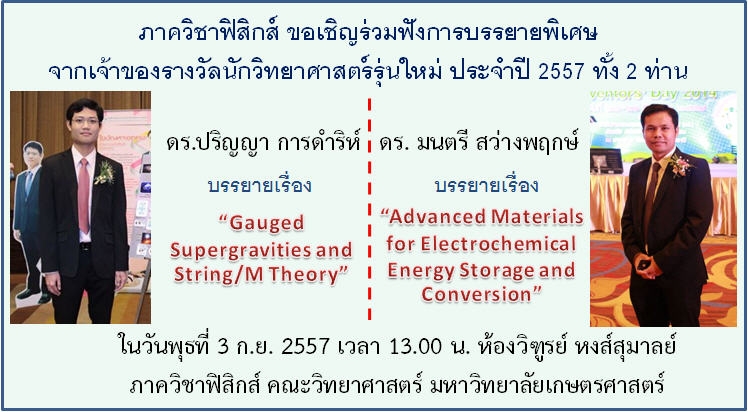ภาควิชาฟิสิกส์ ขอเชิญร่วมฟังการบรรยายพิเศษ จากเจ้าของรางวัลนักวิทยาศาสตร์รุ่นใหม่ 2 ท่าน ประจำปี 2557 ในวันพุธที่ 3 ก.ย. 2557 เวลา 13.00 น. ห้องวิฑูรย์ หงส์สุมาลย์ ภาควิชาฟิสิกส์ คณะวิทยาศาสตร์ มหาวิทยาลัยเกษตรศาสตร์
1. ดร.ปริญญา การดำริห์ จากภาควิชาฟิสิกส์ คณะวิทยาศาสตร์ จุฬาลงกรณ์มหาวิทยาลัย
บรรยายหัวข้อเรื่อง "Gauged Supergravities and String/M Theory"
Abstract
General relativity predicts the existence of space-time singularities such as black holes and Big Bang at which the theory itself breaks down. The singularities could be regarded to be an artifact of classical general relativity, and a full quantum gravity theory is expected to resolve or remove these singularities. The most promising candidate for a theory of quantum gravity is superstring theory in 10-dimensional space-time. The 11-dimensional M-theory, underlying all five versions of superstring theory, is presently proposed to be a unified theory capable of describing all known fundamental particles and their interactions. All superstring theories and M-theory have (gauged) supergravities as their low energy effective theories. Supergravities play a very important role in string/M theory both in string/M theory compactifications and the AdS/CFT correspondence.
2. ดร. มนตรี สว่างพฤกษ์ จากภาควิชาวิศวกรรมเคมี คณะวิศวกรรมศาสตร์ มหาวิทยาลัยเกษตรศาสตร์
บรรยายหัวข้อเรื่อง "Advanced Materials for Electrochemical Energy Storage and Conversion"
Abstract
Advanced nanocomposite materials (ANMs) consist of porous materials (i.e., metal-organic frameworks, layered double hydroxide (LDH), conducting polymers, and metal/metal oxide nanofoams) and carbon-based materials (i.e., carbon nanotubes, carbon fibres, nanocarbon, graphene, graphene oxide). The ANMs have attracted vast interests due to their large surface areas, unique porous structures, synergic effects, diversified compositions, excellent mass transport, and electronic conductivity.
Such ANMs have been recently produced in our laboratory atDepartment of Chemical Engineering, Kasetsart University using a number of synthetic methods such as electrodeposition, solvothermal, hydrothermal, microwave-assisted, polyol, modified Hummers, and electrospinning and then characterized by various techniques based on spectroscopies (XRD, XPS, XAS), microscopies (SEM, TEM, AFM), and electrochemical techniques. TheANMs have been used as the active materials in fabricating high-performance electrodes ofenergy storage and conversion devices i.e., batteries, supercapacitors,and fuel cells.

